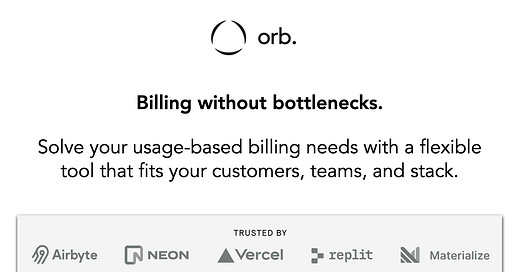
🔺 SaaS Pricing Moves 🔺
💳 Ramp lowered the price of RampPlus from $15/mo to $12/mo.
🪟 Clearbit decreased the credit limit on its free plan, and changed both the credit limits and price range for the Growth plan.
🤖 Jasper changed the Teams plan to the Pro plan, and dropped the price from $99/mo to $59/mo.
🖊️ Grammarly tested showing/hiding price points at the top of the pricing page.
📦 Box introduced lower prices for its Personal Pro and Business Starter plans.
PS. I spotted these updates using PricingSaaS. Try it for free to track competitors and stay ahead of the curve.
This is the last Good Better Best post of 2023.
As always, thank you for reading! I love hearing from all of you — if there’s anything you would like me to cover more or change going into next year, I’m all ears. Just reply to this email to message me directly.
With the new year in mind, I’ve got my eye on a handful of high-level themes that I expect to unpack in the coming months. Listing a short briefing of each below.
1. SaaS Staples vs Discretionary
I’ve been thinking about how to categorize different classes of SaaS products, and believe a common classification from economics makes sense:
Consumer Staples are products that are necessary to survive
Consumer Discretionary are luxury or nonessential products purchased for entertainment, leisure, or pleasure.
I don’t think many SaaS buyers are purchasing products for entertainment or pleasure (at least after this year 😂), but I think the parallel holds when you break it down by essential and nonessential.
Staples would include categories like cloud computing, CRMs, and workspace tools (e.g., email, calendar, chat etc.).
Discretionary might include the outer band of productivity tools (e.g., Miro, Notion), single-use solutions that can be solved by an existing product (e.g., a dedicated webinar solution), or luxury versions of a simple solution (e.g., Superhuman, Asana).
I’m not saying one category is better than the other, just that they’re different. In general, Staples have more pricing power than Discretionary products, and I’d imagine that had a big impact on how these companies fared during a turbulent year.
2. Freemium Anxiety
Two of the biggest trends I’ve seen repeatedly this year are:
Companies getting rid of their free plan.
Companies reducing the usage limits on their free plan.
Beyond that, sentiment around Freemium has never been lower (at least on my timelines). In a post-ZIRP world that prioritizes profitability, SaaS founders are understandably losing patience with delayed monetization.
I could see this playing out a few ways:
Freemium → Free Trial: Sales-supported free trials are one of the most effective ways I’ve seen to close new customers with high(ish) ACVs. Free trials are especially effective when your product creates loss aversion (e.g., users collect data they don’t want to give up). I wouldn’t be surprised to see more companies embrace free trials that are limited on time (e.g., 14 days) or usage (e.g., Zoom’s free plan, which lets users record 25 Looms).
Pulling the plug on PLG : When the OpenView news broke, I saw a lot of takes about the end of PLG. I disagree, and think PLG will remain a critical component to efficient revenue growth for years to come (more on that in a bit). That said, focus is important, and running a PLG motion alongside Sales is not easy. For teams that can’t afford to do both, I could see the case for moving towards a pure Sales motion. Downstream this could mean less public pricing, and more CTAs to “Contact Sales.”
3. Hybrid Motions
Earlier this year I noticed a lot of binary takes when it came to GTM motions and pricing models. Specifically, it felt like a tribal war anytime someone discussed PLG vs Sales-Led Growth.
It felt weird to see such extreme views on these topics, because the biggest players in SaaS often use a hybrid approach. Lately, I’ve noticed a more balanced sentiment, and it seems like folks are losing dogma on each side.
Going forward, I expect hybrid motions to become more mainstream, and easier to execute from day one. Those playbooks are being written today, and sharp SaaS leaders will figure out how to combine PLG and SLG from the get go rather than layering one motion on top of the other later on. [Kyle Poyar’s excellent post on the subject is a great place to start].
A Word from our Sponsor
You could spend a lot of time and money on an internal billing build…that you’ll need to redo in 6 months. Or, you could trust Orb to do it for you - once. Need to experiment with pricing? Orb makes it simple. With Orb, high throughput teams build on core competencies and on the products we know and love rather than on billing.
Want to learn more? Get in touch with our team here. GBB readers get a free trial by mentioning “Good Better Best.”
Whenever you’re ready, there are a few ways I can help you:
PricingSaaS Software: AI-powered pricing alerts for PLG SaaS companies.
PricingSaaS Services: Rapid research and ongoing support for growing SaaS companies.
Free Pricing Consultation: Schedule a call with me to talk through your pricing challenges and determine the best course of action.




